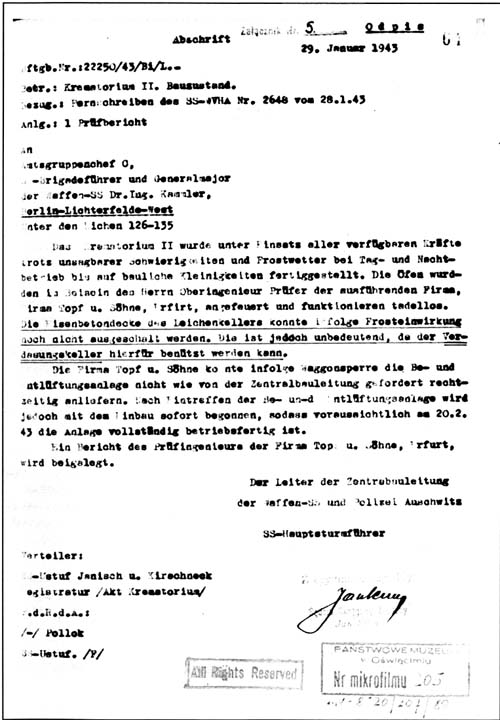
PART FOUR
CHAPTER 1 AUSCHWITZ EXPLAINED BY THE REVISIONISTS — ‘Vergasungskeller’: gassing cellar or gas-generating cellar?
Reply to the affirmations by A R Butz and R Faurisson concerning Leichenkeller 1 or “corpse cellar 1” of Birkenau Krematorium II
| The article by Robert Faurisson that appeared in “Le Monde” of 29th December 1978 on “The problem of the gas chambers” or “The Auschwitz rumor”, triggered a response by G Wellers, entitled “An abundance of proofs”. This was followed by the publication of “A letter from Mr Faurisson”, in right of reply, and by virtue of this same right, G Wellers replied with a text entitled “An inspired novel”. Still not admitting defeat, Faurisson sent yet another reply to the newspaper, requesting “One proof … one single proof”, which the editors of “Le Monde” refused to publish. This epistolatory duel in the press was the start of “The Faurisson Affair” in that it brought the question to the attention of the general public. Keeping strictly to German source documents, Georges Wellers counter-attacked using only ONE LETTER, that of 29th January 1943 [Document 1]. Not reasoning like a revisionist, it seemed to him that this document, backed up and authenticated by the testimony of survivors and of the SS themselves, would suffice. It was in fact the only material “criminal proof” that he had available. 1t was effective, and Faurisson was never able to produce a valid counter-explanation, only very weak arguments bordering on the foolish. Neither Wellers nor, fortunately, Faurisson, were aware that the “slip” contained in this letter, as it was presented in 1978, was historically unusable because incomplete. It lacked Kurt Prüfer’s clarifying report, unknown in France at the time, but found subsequently in the Auschwitz. Museum Archives [Documents 2 and 2a]. To affirm, SOLELY on the basis of the letter of 29th January 1943 that the term “Vergassungskeller” designated a homicidal gas chamber installed in Leichenkeller 1 / corpse cellar 1 of Krematorium II was irresponsible, for though “gas chamber” was correct, there was no proof that it was “homicidal”, for to be able to demonstrate this, the following factors must all he taken into account and a number of steps must necessarily be followed: |
|
| a) | The letter of 29th January 1943 DOES NOT STATE which of the Leichenkeller of Krematorium II the SS are referring to. Drawing 932 shows that THREE Leichenkeller were planned, numbers 1. 2 and 3 [Documents 3 and 4]; |
| b) | Two other Bauleitung drawings of Krematorium II, numbers 1311 and 2003. show that Leichenkeller 3 was converted for other functions nothing to do with its original purpose; |
| c) | The report by the engineer responsible for the installations, Kurt Prüfer, clearly states that it is Leichenkeller 2 from which the shuttering could not yet be removed; |
| d) | The only remaining Leichenkeller, designated by Bischoff as the Vergassungskeller, is therefore Leichenkeller 1. His letter means above all that it is to not be used for the moment as a “gassing cellar”, but as a “corpse cellar”, i.e. a “morgue”. |
| e) | The letter shows that the SS called Leichenkeller 1 of Krematorium II the Vergassungskeller / gassing cellar. The existence of a gas chamber in the basement of Krematorium II is thus proven, BUT THAT IS ALL. It is not until this “slip” is compared with and united with others, that the evidence that this was in fact a homicidal gas chamber becomes overwhelming. |
| To date, no valid argument to refute this interpretation has been found by the revisionists. The American Arthur R Butz in his book, “The Hoax of the Twentieth Century” (Historical Review Press, Brighton 1977) writes in Chapter IV on Auschwitz: | |
“Now the word “Vergasung” has two meanings. The primary meaning (and the only one in a technical context is gasification, carburation or vaporization … In any case it is obvious that the crematoria at Auschwitz required equipment for “Vergasung” in order to inject a fuel air mixture into the ovens and that the translation of NO-4473 [the letter of 29th January 1943], should be revised, possibly to “gas generation cellar”. I have confirmed this interpretation of the “Vergasungskeller” with technically competent sources [!] in Germany” (page 121) |
|
| When R Faurisson, somewhat surprised (to say the least), it would appear, by NO-4373, had to find an answer quickly, he purely and simply in his second article in “Le Monde” and then in his “Statement the the defense”, page 85, copied Butz argument, foolishly | |
|
|
|
 |
Document 1: Letter of 29th January 1943 from SS Hauptsturmführer Bischoff, head of the Auschwitz Bauleitung, to his superior SS-General Kammler. [ [PMO microfilm No 205, volume 11 of the Hoess trial, Annex 5. certified by Judge Jan Sehn as being a true copy. Original in the PMO archives, file BW 30/34, microfilm 1060, page 100] |
|
|
|
| Translation of the passage underlined: | |
| It has not yet been possible to remove the shuttering from the reinforced concrete ceiling of the corpse cellar because of the frost. However, this does not matter because the gassing cellar can be used for the purpose | |
